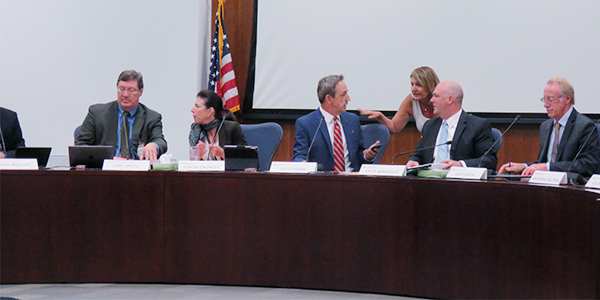By Hudson Sangree
The effort to expand CAISO’s Western Energy Imbalance Market from a real-time trading platform to a day-ahead market took a significant step forward Wednesday, when members of the ISO’s Board of Governors and the EIM’s Governing Body said they supported launching a stakeholder process in October.
The first step will be an issue paper. Then the stakeholder process is expected to continue well into next year, said Keith Casey, CAISO’s vice president of market and infrastructure development. It will address issues such as resource sufficiency in a tightening Western market and interstate transmission challenges, ISO staff said.
Board Chair David Olsen and EIM Governing Body Chair Carl Linvill gave their verbal support to the stakeholder process; there was no formal vote. The occasion was a briefing on the results of an eight-month feasibility study of the extended day-ahead market (EDAM).
Fourteen current and future EIM entities, in addition to CAISO, participated in the assessment.
The non-CAISO entities wrote a joint letter to ISO and EIM leaders emphasizing they have not committed to the EDAM and want to make sure it addresses a number of concerns, including the continued independence of the Governing Body and the representation of a range of interests from across the West.
A continuing worry among EIM participants is that California politicians and CAISO might try to dominate the regional market. CAISO’s bid to form a Western RTO stalled in part because CAISO’s governors are appointed by the governor and approved by the State Senate.
“The issues to be resolved to make EDAM a reality should not be underestimated,” the entities wrote. Those that signed the letter included Arizona Public Service, Idaho Power and PacifiCorp.
“Governance structures must be considered that reflect the new market design and the legitimate interests that all within the broader market footprint will have in the operation and rules of the day-ahead market,” it said. “In addition, it is likely EDAM will need to include a test to ensure that all participating balancing authorities are not leaning on neighbors to meet their continued reliability obligations.”
Estimated Benefits
A goal of the feasibility study was to estimate the financial benefits to EIM participants to gauge their potential level of interest, Mark Rothleder, CAISO vice president of market quality, told the board and Governing Body.
The EIM has continued to add new members, but some entities from the interior West have cited the economic bonuses as their primary motivation while lamenting the tie to California. The uneasy political alliance is part of the reason SPP recently launched its own Western Energy Imbalance Service. (See WAPA, Basin, Tri-State Sign up with SPP EIS.)
Rothleder said the study group and its consultants, E3 and Brattle Group, had projected the operational benefits of a day-ahead market at $119 million to $227 million annually, which he called a conservative estimate. (In their letter, the EIM entities pointed out that the estimate doesn’t consider how “benefits may be reduced should only a limited number of EIM entities elect to participate in EDAM.”)
The expected financial benefits will come partly through more efficient day-ahead hourly trading and better use of available transmission in an organized market, according to Rothleder’s presentation.
The EIM says its real-time market has saved participants more than $736 million since it began in 2014.
A day-ahead market could limit the curtailment of excess renewable resources by up to 2 GWh a year, sending energy where it’s needed and producing tens of millions of dollars in additional revenue for generators, Rothleder said.
Environmentalists have generally supported regional markets as a way to maximize the sharing of renewable resources, for example, by sending wind energy from New Mexico to California and solar power from California to the Pacific Northwest.
Jennifer Gardner, senior staff attorney with Western Resource Advocates and a member of the committee that nominates Governing Body members, praised the move in a news release. Adding a day-ahead market to the EIM would “allow utilities to better plan for and optimize renewable energy use on the grid through more efficient unit commitment and more effective integration of variable energy resources across a larger footprint,” Gardner said.
Sarah Edmonds, transmission director at Portland General Electric, and Jim Shetler, general manager of the Balancing Area of Northern California, were part of the assessment team. They spoke at Wednesday’s meeting and acknowledged the challenges and effects of a day-ahead market that stretches across the Western Interconnection.
“This is going to be significant and complex,” Edmonds said. “It could have consequences for the Western market as a whole.”
EIM Governance Review
The board and Governing Body also named 10 members of a committee to review the governance structure of the EIM, as required by the market’s original charter. (See CAISO OKs EIM Governance Review.)
The charter recognized that the EIM would evolve over time, and the expansion to a day-ahead market could necessitate governance changes, said Stacey Crowley, CAISO vice president of external affairs.
Members named to the Governance Review Committee (GRC) included Gardner; Therese Hampton, chair of the EIM’s Regional Issues Forum and executive director of the Public Generating Pool in the Pacific Northwest; and Eric Eisenman, PG&E’s director of ISO and FERC relations.
Their colleagues nominated Governing Body member Valerie Fong and CAISO Governor Angelina Galiteva as representatives to the GRC.
Board Chair Olsen said he’s hoping to add another member from the EIM’s investor-owned utilities because he felt the committee was light on IOU representation.
The committee will eventually include 11 to 13 members, said Peter Colussy, CAISO manager of regional affairs.





